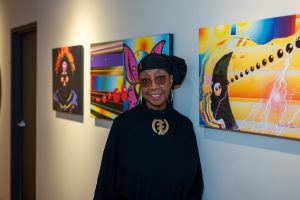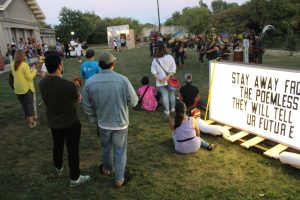The Artists’ Cooperative Residency and Exhibitions, better known as ACRE, isn’t your typical residency. It is a science lab, playground, classroom, workshop, and a studio. It is a place for artists to make new connections or strengthen old ones, and then learn the glamour and grunt of putting together an exhibition from beginning to end. In one year ACRE has become all of that and more for quite a few artists inside and outside of Chicago. Whether you’re speaking of the 100+ acres of land in Steuben, Wisconsin or ACRE Projects exhibition space in Chicago, founders Emily Green and Nicholas Wylie have created quite the breeding ground for interaction between some very promising artists. (The results of ACRE‘s first year can be seen in the dozens of weekly exhibitions on their 2010-2011 calendar.) To kick off a series of SIFC interviews with ACRE and some of their residents I sat down with Emily Green to learn more about how ACRE started, her background in photography and textiles, where ACRE will be going in the future and to get her reflections on its inaugural year.

Tempestt Hazel: ACRE is you and Nicholas Wylie’s brainchild. Can you talk a little about where it came from and how it was born? What idea it stemmed from?
Emily Green: Well, I guess it goes back to the organization that Nick and I were involved with before, Harold Arts, which is still around but he and I broke off to start something of our own about a year ago. Harold started when Nick had met Joe Jeffers at an art fair that they were both working at. [Jeffer’s] grandfather had just passed away leaving to his family a portion of this large farmland in Ohio. He really loved going out there and, being an artist himself, he was thinking about ways to get artists out there. He and Nick started scheming ideas which led to starting a residency program–but in a much looser sense at that point.
Nick and I went to high school together, actually, where we were friends and both artists. He knew that I was really interested in the idea of artist communities or artist residencies because I had been talking about it even in high school—my desire to start something like that. So, he brought me in at that point– when they were starting to think about and develop this idea and starting to recruit other artists to join. Jamie Branch, a jazz musician, was also involved at this time. I was less involved at the beginning but the four of us planned to go out for a few days in the summer and we all reached out to our artist friends and said, “Hey, do you want to come out? Let’s just go out there and see what it’s about, make some art and have fun.”

Between them and all their contacts we got a small group of people–maybe twelve to fifteen people, to go out there. We had a great time and got a lot out of making work in that type of environment. We all just threw thirty bucks in for food, a local woman took kindly to us and started hanging out and cooking us dinner and stuff like that. We just had such a great time and started to think, “If we’re going to do this let’s start thinking about how we’re going to make it legitimate.”
I, actually, at that point left and moved to California to go to graduate school at California College of Arts in San Francisco. Ultimately, I was only there for a semester. It was a little early for me to head off to graduate school. Moving so far away was hard. But when I was making the decision to move back to Chicago I didn’t want to go back and be aimless for the next undetermined amount of time. Harold was something that I was interested in and wanted to be a part of. So, I called up Nick and said, “I’m moving back and I want to be more involved.” They were really excited to have more help because I think no one quite knew what they were getting into, they were just beginning to apply to be incorporated. When I came into the picture I took on the 501(c)(3) application. We were all working together as directors.

But it really came out of this idea that we were all out of school, we didn’t really have that community around us anymore but we really liked being involved in a community and having people to think and talk about art with, share our own art with, and also a social group. That’s what led to Harold.
When [Nick and I] decided to leave Harold we were approached by [Bob] who had property in Wisconsin that he’d been building up for the last twenty years with the idea of having it used as a conference center or a place for symposiums. He’s a creative guy, very supportive of artists and of what we were doing. He’s in the demolition business. He comes in and salvages materials from demolished buildings, turns it around and sells it. So, his property is all salvaged timbers from Chicago.
He’d heard of us when we first started because we had some mutual friends who had been working for him. We were on his radar and he was on our radar. He approached us finally when he felt like he was ready to host something and that was what led to the split. It was a little more complicated than that but we decided that this sounded like an amazing place to be and we wanted to pursue it.
It was really that experience with Harold that informed ACRE.

TH: The experience with Harold made it a little easier to start it?
EG: Absolutely. It’s kind of amazing. We’re just one year old now and have had so much attention. People have been really impressed with how smoothly the program is going so far. I think sometimes I do need to remind people that we’ve been doing this for about five years now.
TH: It’s not as if you just came out of the blue, decided to do this and were instantly really good at it…
EG: Exactly.
TH: Why do you think ACRE is getting so much attention? Do you believe that ACRE is filling a void, and maybe that’s why?
EG: I think in some way, yes. That’s kind of the general idea. We’re trying to work with people who are maybe just out of school or are looking for a community aside from school because it feels a little bit more organic and natural to reach beyond what an institution has to offer. But I think that we also are just sort of insane and took on a lot and people say, “Wow! You have a show every week?!” So, that’s kind of impressive, I guess. [laughs]
TH: What’s the process for selecting the artists to participate?
EG: We have an application and we try to keep it pretty simple–a quick form, work samples, and a little bit of writing about what the artist would do with their time and why this is an important opportunity for them right now. Then we have a panel that comes together to review the applications. This may change this year depending on how many applications we get. We got a little over a hundred last time. Because we got so many more than we expected, we ended up adding another session so that we didn’t have to turn so many people down.

About half of [the panel] is made up of artists, people we’re working with, maybe our volunteers and advisors. The other half are people we’re not necessarily working very closely with–professors, curators and others from the Chicago art community who would lend a new set of eyes and a different bias. It’s a blind review so each application is assigned a number and we’ll go through, project the sample work and read the proposals. The work and the proposal each gets a one to five score and we tally it up. From there we make the selections based on the scores.
This year we’ll be looking more closely at the mediums people are working with and places they are coming from to try to have more of a balance. But we try to make the admissions process as simple on everyone as possible, which is why we did it just based on the scores last time.
TH: So, you were heavy on some mediums and light on others?
EG: We’ve always been heavy on photographers. That medium is suitable out there in terms of being portable. But this past year we got a pretty nice range. One issue that we ran into during one session was that it was very Chicago heavy and there were a lot of people who already knew each other. That, I think, left out some of the others who weren’t coming from Chicago and didn’t really know anyone. So, that’s something that we’re thinking about in terms of striking a better balance of residents.
TH: Where are you getting applications from?
EG: The majority of our applicants are coming from Chicago. We’ve also had a few people from New York and L.A., St. Louis, Philadelphia, one applicant from Canada. We’re working with the people that work with us and their networks, It tends to be very Chicago heavy at this point. Nick recently came out of UIC, so there were a lot of applicants from there and some who had attended Harold in previous years.

TH: What types of facilities are available to the artists at ACRE?
EG: We go out there and set up our own kind of facilities. We set up a wood shop, screen print studio and a recording studio. Plus some communal workspaces that are indoor or on porches.
Bob, who owns the property, was really gracious because his place is just littered with random materials and things like that and to an artist that is just so exciting. We asked if we could use some of it. He marked off some areas where we were allowed to take things from. That was really nice. It cut down on the cost for buying things and bringing things.
TH: Besides ACRE, what is your involvement in the visual arts? You mentioned before that you’re an artist yourself.
EG: Yes. I went to school for art. Both of my parents were photographers. We had our own darkroom in the basement when I was growing up and I’ve been doing photography since I was thirteen. Then, I was lucky enough to go to a high school with a darkroom so I was able to get pretty immersed in photography. I went to the Art Institute, and for a while I was really thinking of myself as a photo major, but I ended up switching completely and haven’t really done any photography for a long time. What happened is that basically the photo classes at the Art Institute are extremely popular and somehow I ended up with the worst spot for registration. I could never get into a photo class. So, I ended up, just on a whim, signing up for Introduction to Fibers and I loved it. I learned how to weave and ended up taking a weaving class every semester for the rest of my time in school.
TH: What is it that you found in weaving and fibers that you maybe didn’t in photography?
EG: I actually think that it was something that I found in photography–the part that I was most attracted to, which is the real hands-on involvement in creating. The thing I loved about photography was being in the darkroom. And that was slowly starting to go away. I love working with my hands, paying attention to detail and repetition and meditative processes. I’ve always found process-oriented activities or work comes naturally to me. Usually my ideas come out of the process and the physical making.
TH: When you go to ACRE do you participate and create?
EG: Actually, this year I was able to work on my own work–that’s never happened to me. At Harold in the past, I never had the time. I was always too busy running the program. But this past year by the time we were into our final session and things were going pretty smoothly, I could take the time.
TH: How do you balance those things–taking time to develop your own work and also maintain ACRE?
EG: It’s rather difficult. I’m sort of lucky in that my day job is a textile-related. I work for an artist who has a textile restoration business, so I’m doing repairing and restoration of textiles. That satisfies a little bit of that need to be using my hands. It’s been a great way to keep up my sewing skills and be around textiles which has been really helpful in terms of that balance because definitely my own practice has gone by the wayside. I go through weird spurts where I’ll go a year without making anything then I’ll finally have a project, work on it for a few months and then go back to all the ACRE stuff I need to focus on.
This is Part One of the interview with Emily Green. Stay tuned for Part Two in the coming weeks.
In the meantime, find out more about ACRE and the dozens of ACRE Exhibitions happening between now and June at www.acreresidency.org.





